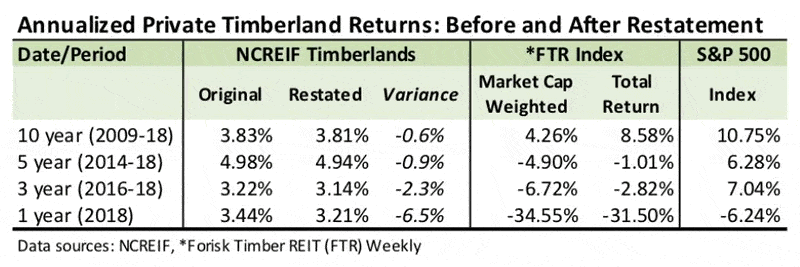Capital continues to flow into wood-using mills and private timberlands, including publicly-traded timberland-owning firms. The benefits of timberland continue to speak to investors during periods of uncertainty: they secure wealth and produce cash through the cycle and over time. And part of managing these investments requires consistent attention to available data and key metrics of performance.
Revisiting 2018 Timberland Returns
On February 28, 2019, NCREIF – the National Council for Real Estate Investment Fiduciaries – sent out a note regarding the restatement of the Q4 2018 Timberland Property Index. Timberland investors, investment managers, and industry researchers and analysts (including Forisk) often cite this index for benchmarking private timberland investment returns and trends. NCREIF’s note included the following summary:
The Fourth Quarter 2018 NCREIF Timberland Property Index has been restated due to a significant reporting error on one property. The impact at the National Level is a 22 basis point total return drop…
So how does this restatement affect the multi-year metrics we use for estimating long and short-term performance? The table below summarizes the implications by comparing annualized results before and after the restated returns versus select benchmarks for a range of time frames (periods).

Overall, the restated Q4 2018 returns have minimal impacts for comparing the U.S.-wide timberland returns over longer time spans, such as five and ten years. For example, the restated numbers for the past ten years dropped 0.02% (from 3.83% to 3.81%). Alternately, the restatement dropped 1-year 2018 returns by 22 basis points, from 3.44% to 3.21% (rounded). For comparison, ten-year U.S. Treasuries yield (as of today) about 2.90% and the 30-year yields 3.06%.
Still, private timberlands, when compared to public REITs and the S&P 500 in the table, retain their relative stability and positive cash flow generation, regardless the time frame. [Fortunately for many investors and 401K plans, 2019 YTD has seen a bounce in equities.]
In sum, know and remember why you want timberlands in the portfolio. You don’t really buy timberland to outperform the market. Objectives such as wealth preservation matched with realistic return expectations provide a useful starting point. In addition, timberlands generate some cash and diversify the portfolio (while also providing a place to hike, fish and hunt…).
This content may not be used or reproduced in any manner whatsoever, in part or in whole, without written permission of LANDTHINK. Use of this content without permission is a violation of federal copyright law. The articles, posts, comments, opinions and information provided by LANDTHINK are for informational and research purposes only and DOES NOT substitute or coincide with the advice of an attorney, accountant, real estate broker or any other licensed real estate professional. LANDTHINK strongly advises visitors and readers to seek their own professional guidance and advice related to buying, investing in or selling real estate.










Add Comment